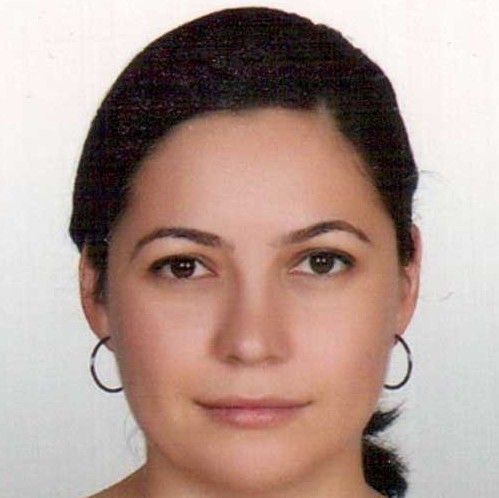Research Article
Issue Reviewers




 Web
Web





 Web
Web

Bachelor: Ege University, Faculty of Agriculture, department of Agricultural Economics, 1989.
Master Degree: Ege University, Faculty of Agriculture, department of Agricultural Economics, 1993.
PhD: Ege University, Faculty of Agriculture, department of Agricultural Economics, 1999.

Dr. H. Ece SALALI is an Assistant Professor at Ege University, Faculty of Agriculture, Department of Agricultural Economics. She received her master´s degree from the Centre for Environmental Studies, Institute of Natural and Applied Sciences, in Ege University (Izmir). She completed her Ph.D. thesis entitled “Measurement of Producer and Consumer Sensitivity in Local Wheat Varieties in Aegean Region in Terms of Conservation of Agricultural Biodiversity and Sustainable Use” at Ege University (Izmir), Institute of Natural and Applied Sciences, Department of Agricultural Economics, Agricultural Policy and Extension. She conducted a research project on the benefits of using local varieties to reduce the impact of climate change on water resources. Her research interests include environmental valuation, agricultural biodiversity, climate change, environmental attitudes of consumers and farmers, and environmental case studies in the Aegean region. She is the author or co-author of more than 50 research articles, oral and poster presentations, and reviews in Agricultural Economics.

Associate Professor Dr. Makbule Nisa MENCET YELBOGA has over two decades of experience in agricultural economics, environmental economics, and agricultural policy. With a strong academic background in economics and agricultural economics, she has studied and worked in Turkey, Greece, and Spain. Her doctoral dissertation, funded by The Research Council of Turkey, focused on the ecological and economic analysis of greenhouse tomato production in Antalya, Turkey. Dr. Mencet Yelboğa has been a lecturer and researcher at Akdeniz University's Department of Agricultural Economics since 2002, participating in numerous national and international projects and publishing extensively in her field. Her current research interests include agricultural waste and its environmental impacts.


Biography
(Dr. Mithat Direk from Selçuk University, Konya-Türkiye)
Mithat Direk ORCID number (0000-0002-7232-9089)
Official mail: mdirek@selcuk.edu.tr; mithatdirek@gmail.com
Official link in his university : https://selcuk.edu.tr/Person/Detail/mdirek
Dr. Direk received B.S. degree from Çukurova University in Adana, Türkiye. He got his MSc. and PhD. degrees in Agricultural Economy Department from the University of Çukurova in Adana, Türkiye also. He was the founding faculty member of the Department of Agricultural Economy, from the Sütçü İmam University, Kahramanmaraş, in Türkiye. He had worked Çukurova, Kahramanmaraş Sütçü İmam University, which was head of department of agricultural economics, Kahramanmaraş, Türkiye. He works in Selçuk University since 1997.
He worked as the director of the Taşkent Vocational Scholl at 6 years, in Taşkent, Konya, Türkiye. He was also a Visiting Professor one month at Tanta University, Egypt, 4 months North Dakota State University, USA, and he is visiting many of countries for research and technical subjects. He worked on international relationships, organizing conferences, supervising projects throughout the world. He was the author of the book entitled “Agriculture History” published in 2012 and second edition in 2014, which is a new concept in agriculture sector. He is the editor of the some book entitled conferences proceeding. These proceeding books brought new dimensions to agricultural sector and agro food industry. His current research interests include sustainable agriculture and food marketing. His interest of taking pictures as like amateur photographer and he was opened exhibition “Seasons in Taşkent” at 2001. He is as a writer of a number of books and more than 200 papers published in international journals and conference proceedings. He recently writes some popular articles in newspaper daily and monthly journal in Türkiye. He is also an organizer as well as chair series of International Conference on Sustainable Agriculture and Environment performed six times in different countries. He is an expert especially in agricultural marketing, organization, and cooperatives.








 Web
Web
Aim & Scope
Agricultural Economics journal aims to disseminate the results of original, qualified and important research conducted in the field of agricultural economics, agricultural business, agricultural policy and extension, to all regions of the world.
The subject coverage analyzes at every scale, from consumption to land use and the environment, from micro-level units to markets and macro economy. In this context, studies in the field of agricultural economics, agricultural management, agricultural policy, natural resources and environment, rural development, marketing, international trade, agricultural extension and communication are evaluated. Methodologies used in research include econometric analysis and forecasts, statistical hypothesis testing, optimization and simulation models, descriptive reviews and policy analyses.
Author Guidelines
1. The journal is published twice a year, in June and December.
2. Original research articles prepared in the field of Agricultural Economics that have not been published before, as well as compilation and/or opinion articles (maximum 2 in each issue) in line with the purpose of the journal are published in the journal.
3. A maximum of two articles by an author can be included in the same issue, provided that their name order is different.
4. Scientific responsibilities of the articles belong to the authors.
5. Article applications are made at https://dergipark.org.tr/.
6. During article applications, all fields required to be submitted in Turkish and English (name and surname of each author, ORCID number, e-mails, article summary, keywords and all sources used, etc.) must be filled in carefully. When entering data into the Dergipark system, the first letter of the words should be capitalized and the rest should be lowercase.
7. Research articles are generally written in either Turkish or English; It should be prepared under the main headings of Title, Summary (structured), Abstract (structured), English and Turkish Keywords, Introduction, Materials and Methods, Research Findings, Discussion, Conclusion and References. If desired, Research Findings and Discussion sections can be written under a single heading. According to the TRDizin index, research includes surveys, interviews, focus group studies, etc. If it envisages collecting data through means, ethics committee approval must be obtained from ethics committees established for human research, and the title "ethics statement" must be stated before the bibliography at the end of the research.
Ethics Statement
……………………….. Ethics Committee ………. It was found ethically appropriate at the meeting dated and numbered ……….. (Protocol No: ……….Approval No:…). etc
Writing rules and process in review articles are the same as in research articles. However, review articles must contain at least 20 sources, at least 75% of which belong to the last 10 years, and must not have been previously published in any publication. In addition, there is no obligation to use other titles in review articles, except for the main title Introduction and Conclusion. The author can determine the titles himself in review articles, but the abstract is written structured as in a research article. A maximum of two reviews can be published in an issue, depending on the number of articles in that issue.
8. Points to consider for structured “Summary” and “Abstract”
a. It should be presented under 4-7 subheadings and in accordance with the structure below.
Purpose (required)
Design / methodology / approach (required)
Findings (required)
Research limitations/implications (if any)
Practical applications (if any)
Social implications (if any)
Originality/value (required)
b. “Abstract” and “Abstract” should be no more than 250 words and should be structured and should be positioned separately from the main text.
c. After leaving one line space after "Abstract" and "Abstract", "Keywords" and "Keywords" should be included, consisting of 3 - 6 words, and should be different from the words in the title.
D. At least 2 and at most 4 Jel codes describing the article should be added under the keywords.
9. Decimal numbers in the article should be separated by dots.
10. Graphs, maps, photographs, pictures and similar presentations should be named "Figure", and presentations of numerical values should be named "Table". English nomenclatures should also be included under the Turkish nomenclatures of Figures and Tables. All tables and images given should be cited in the text, and figures and tables should be included in the article.
11. In terms of the effectiveness of the literature review in research articles, it is recommended to cite at least 10 original articles on the subject.
12. Article layout;
a. It should be written in Microsoft Word software (docx format; Word 2007 and above), in Times New Roman font and without indenting the first line of the paragraphs. Page margins should be set at 2.5 cm from all sides.
b. Each page in the article should be numbered.
c. The Turkish and English title of the article should be written in bold, 14 point font, centered and in lowercase letters with the first letters capitalized.
D. Section headings at the 3rd level should be used at most. First-level headings should be left-aligned, bold, 12-point font, and the first letter of each word should be capitalized. Second-level headings should be bold, left-aligned, and only the first letter of the first word should be capitalized. Although third-level headings are not recommended, they can be used if necessary and should be written flush to the left and with only the first letter of the first word capitalized.
to. The main body of the text should be written with 1.5 spacing, Times New Roman, 12 point font and justified. The article should be limited to a maximum of 20 pages, excluding the reference list. All paragraphs should start from the left margin. The text must be completely justified. There should be no spelling. Highlighting text using bold or underlined text is not recommended.
f. The names of the author(s) should be written in bold 12-point font, with the first name in light and lowercase letters, the surname in capital letters, and a tab and a space, without specifying the title, after a line space under the title of the article.
g. Academic and/or other institutions related to the authors should be stated in 10-point font using superscript numbers. Additionally, the e-mail address of the corresponding author should be shown with an asterisk on a separate line.
13. Articles must be prepared in accordance with the Harvard reference system (Emerald's Harvard referencing style), citation and referencing rules. In citations within the article, the "author and date" system should be used, except in special cases. If multiple sources are to be cited at the same time, publications should be separated by semicolons and given in chronological order. For example: (Soyadı, 2002; Soyadı et al., 2009; Soyadı, 2010; Soyadı and Surname, 2012). In works with two authors, author names should be separated by "and" (in sources written in a foreign language, "and"), in works with multiple authors, "et al." (“et al.”) should be used in foreign language sources. For example: (Surname, 2007), (Surname and Surname, 2005), (Soyadı et al., 2003). Multiple uses of publications with more than one author or single author should be done in historical order, and when using multiple publications in the same year, alphabetical order based on the first author should be taken into consideration. For example: (Atıcı and Armağan, 2019; Yercan and Kınıklı, 2019). When citing different sources published in the same year by the same author/institution/etc., alphabet letters should be used after the year.
Examples
……about teaching quality (Berk, 2013). ……. SET administration (Avery et al., 2006). ……..on average student ratings (Griffin et al., 2014; Nulty, 2008; Spooren et al., 2013). ……evaluate SET scores (Boysen, 2015a, 2015b; Boysen et al., 2014; Dewar, 2011).
14. All literature cited in the text should be included in the "References List". Works that are not cited in the text should not be included in the reference list. The list of references should be given in alphabetical order and according to the author-date system. If two or more publications by the same author are used, the older publication should be given first in the References List. The first letter of each word of the book and book chapter name must be capitalized. Publications of an organization should be given with their publication number, otherwise the name and city of the printing house where they were published should be stated. The name of the journal in which the literature is published should be written clearly, without abbreviations. When writing references, the first line should be aligned to the left, and the following lines should be drawn in 0.5 cm. Examples of literature writing style are given below. (Emerald's Harvard referencing style)
References to other publications in your text should be written as follows:
Single author: (Adams, 2006)
Two authors: (Adams and Brown, 2006)
Three or more authors: (Adams et al., 2006) Please note, ‘et al' should always be written in italics.
A few other style points. These apply to both the main body of text and your final list of references.
When referring to pages in a publication, use ‘p.(page number)’ for a single page or ‘pp.(page numbers)’ to indicate a page range.
Page numbers should always be written out in full, e.g. 175-179, not 175-9.
Where a colon or dash appears in the title of an article or book chapter, the letter that follows that colon or dash should always be lower case.
When citing a work with multiple editors, use the abbreviation ‘Ed.s’.
At the end of your paper, please supply a reference list in alphabetical order using the style guidelines below. Where a DOI is available, this should be included at the end of the reference.
For books
Surname, initials (year), title of book, publisher, place of publication.
e.g. Harrow, R. (2005), No Place to Hide, Simon & Schuster, New York, NY.
For book chapters
Surname, initials (year), "chapter title", editor's surname, initials (Ed.), title of book, publisher, place of publication, page numbers.
e.g. Calabrese, F.A. (2005), "The early pathways: theory to practice – a continuum", Stankosky, M. (Ed.), Creating the Discipline of Knowledge Management, Elsevier, New York, NY, pp.15-20.
For journals
Surname, initials (year), "title of article", journal name, volume issue, page numbers.
e.g. Capizzi, M.T. and Ferguson, R. (2005), "Loyalty trends for the twenty-first century", Journal of Consumer Marketing, Vol. 22 No. 2, pp.72-80.
For published
conference proceedings
Surname, initials (year of publication), "title of paper", in editor’s surname, initials (Ed.), title of published proceeding which may include place and date(s) held, publisher, place of publication, page numbers.
e.g. Wilde, S. and Cox, C. (2008), “Principal factors contributing to the competitiveness of tourism destinations at varying stages of development”, in Richardson, S., Fredline, L., Patiar A., & Ternel, M. (Ed.s), CAUTHE 2008: Where the 'bloody hell' are we?, Griffith University, Gold Coast, Qld, pp.115-118.
For unpublished
conference proceedings
Surname, initials (year), "title of paper", paper presented at [name of conference], [date of conference], [place of conference], available at: URL if freely available on the internet (accessed date).
e.g. Aumueller, D. (2005), "Semantic authoring and retrieval within a wiki", paper presented at the European Semantic Web Conference (ESWC), 29 May-1 June, Heraklion, Crete, available at: http://dbs.uni-leipzig.de/file/aumueller05wiksar.pdf (accessed 20 February 2007).
For working papers
Surname, initials (year), "title of article", working paper [number if available], institution or organization, place of organization, date.
e.g. Moizer, P. (2003), "How published academic research can inform policy decisions: the case of mandatory rotation of audit appointments", working paper, Leeds University Business School, University of Leeds, Leeds, 28 March.
For encyclopaedia entries
(with no author or editor)
Title of encyclopaedia (year), "title of entry", volume, edition, title of encyclopaedia, publisher, place of publication, page numbers.
e.g. Encyclopaedia Britannica (1926), "Psychology of culture contact", Vol. 1, 13th ed., Encyclopaedia Britannica, London and New York, NY, pp.765-771.
(for authored entries, please refer to book chapter guidelines above)
For newspaper
articles (authored)
Surname, initials (year), "article title", newspaper, date, page numbers.
e.g. Smith, A. (2008), "Money for old rope", Daily News, 21 January, pp.1, 3-4.
For newspaper
articles (non-authored)
Newspaper (year), "article title", date, page numbers.
e.g. Daily News (2008), "Small change", 2 February, p.7.
For archival or other unpublished sources
Surname, initials (year), "title of document", unpublished manuscript, collection name, inventory record, name of archive, location of archive.
e.g. Litman, S. (1902), "Mechanism & Technique of Commerce", unpublished manuscript, Simon Litman Papers, Record series 9/5/29 Box 3, University of Illinois Archives, Urbana-Champaign, IL.
For electronic sources
If available online, the full URL should be supplied at the end of the reference, as well as the date that the resource was accessed.
Surname, initials (year), “title of electronic source”, available at: persistent URL (accessed date month year).
e.g. Weida, S. and Stolley, K. (2013), “Developing strong thesis statements”, available at: https://owl.english.purdue.edu/owl/resource/588/1/ (accessed 20 June 2018)
Standalone URLs, i.e. those without an author or date, should be included either inside parentheses within the main text, or preferably set as a note (Roman numeral within square brackets within text followed by the full URL address at the end of the paper).
For data
Surname, initials (year), title of dataset, name of data repository, available at: persistent URL, (accessed date month year).
e.g. Campbell, A. and Kahn, R.L. (2015), American National Election Study, 1948, ICPSR07218-v4, Inter-university Consortium for Political and Social Research (distributor), Ann Arbor, MI, available at: https://doi.org/10.3886/ICPSR07218.v4 (accessed 20 June 2018)
Emerald’s Harvard referencing style
https://www.emeraldgrouppublishing.com/how-to/authoring-editing-reviewing/use-harvard-reference-system
Ethical Principles and Publication Policy
ETHICAL PRINCIPLES
The publication process of the Journal of Agricultural Economics is carried out within the framework of ethical principles, and all stakeholders involved in the process must comply with the ethical principles specified by the Committee on Publication Ethics (COPE) . You can find detailed information about the ethical principles summarized below at https://publicationethics.org/ .
Attention to Authors
Journal of Agricultural Economics is the peer-reviewed scientific publication of the Agricultural Economics Association.
The magazine is published semi-annually, in the sixth and twelfth months, and a volume is completed in two issues.
Primarily research and original compilations can be published in the journal.
In order for an article to be taken into peer review and published, it must not have been previously published or sent to another journal and must be deemed suitable for publication by the Editorial Board. Papers presented at symposiums and congresses but not published in the congress book may be evaluated. The Editorial Board has the right to publish or not publish the article after receiving the evaluation of two referees (a third referee if necessary) regarding the subject of the article.
Responsibility for the scientific content, results, and whether the article complies with ethical rules in the published articles belong to the authors. The Association of Agricultural Economics, its editors and editorial board are not responsible for the published information.
Articles in Turkish and English are published in the journal.
Author(s) are requested to additionally upload the plagiarism rates of their articles to the system.
The author/s stated that the publication rights were given to the Agricultural Economics Journal Association along with the article, that the article was original, that it was not published anywhere (in Turkish or English) other than the congress notification (only presentation), that it was not sent to another journal for evaluation at the same time, that the article was prepared in full compliance with the journal writing rules. must send a letter stating that
Our journal also complies with the following issues under the heading of ethical rules.
1- Research includes surveys, interviews, focus group studies, etc. If it envisages data collection by means of methods, ethics committee approval must be obtained from ethics committees established for human research, and this approval must be stated or documented in the article.
2- A statement is included in the articles stating that Research and Publication Ethics are complied with.
3- Copyright regulations must be observed for the ideas and artistic works used.
Journal of Agricultural Economics expects authors, readers, researchers, referees and editors to comply with ethical rules during the publication process of studies.
General actions against scientific research and publication ethics
a) Plagiarism: Presenting the ideas, methods, data, applications, writings, figures or works of others as one's own work, in whole or in part, without citing them in accordance with the rules of scientific ethics,
b) Forgery: Producing data that is not based on research. , editing or modifying the presented or published work based on unreal data, reporting or publishing these, presenting a research that has not been conducted as if it had been conducted,
c) Distortion: falsifying research records and data obtained, presenting methods, devices and materials that were not used in the research as if they were used, Not taking into consideration data that is not suitable for the research hypothesis, tampering with data or results to make them fit the relevant theory or assumptions, falsifying or shaping the research results in line with the interests of the people and organizations receiving support,
d) Duplicate publication: Multiple works containing the same results of a research are evaluated in the associate professorship exam evaluations and presenting them as separate works in academic promotions,
d) Unfair authorship: Adding people who do not have active contributions to the article authors, not including people with active contributions among the authors, changing the author order unjustified and inappropriately, removing the names of those who have active contributions from the work during publication or in subsequent editions. f) Slicing
: To present the results of a research as separate works in certain exam evaluations and academic incentives and promotions by improperly dividing it into pieces and publishing multiple publications without citing each other, in a way that violates the integrity of the research.
Stakeholder Responsibilities
1. Authors' Responsibilities
· It must be declared that all data in the article is real and original.
· It is mandatory to make plagiarism, errors, suspicious situations and suggested corrections determined as a result of preliminary evaluation or referee evaluation.
· The "References" of the article or research must be prepared completely and in accordance with the writing rules of our journal.
· Plagiarism and fake data should be avoided.
· The research should not be published in more than one journal.
2. Responsibilities of Referees
· Evaluations are made impartially.
· There is no conflict of interest between the referees and the stakeholders of the article under evaluation.
3. Responsibilities of Editors
· The editor has the responsibility and authority to accept or reject articles. He uses this responsibility and authority appropriately and timely.
· The editor cannot have a conflict of interest regarding the articles he accepts or rejects.
· The editor accepts articles that are original and will contribute to the field.
· The editor rejects incomplete and erroneous research that does not comply with the journal policy, publication rules and level, without any influence.
4. Plagiarism Policy:
All studies submitted to our journal are requested to be scanned in any plagiarism program (iThenticate, etc.) and uploaded to the system by the responsible author. If the similarity rate is over 20%, the article will be rejected.
Article Evaluation and Publication Process
Articles sent to the journal are first pre-evaluated by the writing editor/editor/publication board; It is checked for compliance with the scope and writing conditions of the journal. Articles deemed appropriate are sent to two referees selected on the subject. Referees can vote "rejection", "major revision", "minor revision" or "acceptance". At the end of the evaluation process, the article that receives an acceptance vote from both referees moves on to the typesetting process. The article that receives revision from any referee enters the revision process. If the article receives an acceptance or revision vote from one referee and a rejection vote from another referee, it is sent to a third referee for evaluation. Evaluation reports from the referees are examined by the editor/editorial board and revisions are notified to the author. The article revised by the author is evaluated by the editor and sent to the referees again if deemed necessary. Even if any article receives an acceptance vote from the referees, it may be rejected by the editor/publishing board if the edits made are not deemed sufficient.
An article that has received revision must be re-uploaded to the system within 15 days after making the necessary adjustments. Articles that are not corrected within this period or that do not require additional editing time are removed from the system. During the preparation and typesetting phase for publication, authors may be asked to make edits. In order for the article to be published, the authors are obliged to make the necessary edits at the desired time.
There should be no information about the identities of the authors in the text of the article. This type of information is hidden by the writing editors during the pre-checking stage and the article is sent to the referees.
Price Policy
No fee is charged from the author or institution under any name.
